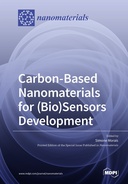Explore

Carbon-Based Nanomaterials for (Bio)Sensors Development
0 Ungluers have
Faved this Work
Login to Fave
Carbon-based nanomaterials have been increasingly used in sensors and biosensors design due to their advantageous intrinsic properties, which include, but are not limited to, high electrical and thermal conductivity, chemical stability, optical properties, large specific surface, biocompatibility, and easy functionalization. The most commonly applied carbonaceous nanomaterials are carbon nanotubes (single- or multi-walled nanotubes) and graphene, but promising data have been also reported for (bio)sensors based on carbon quantum dots and nanocomposites, among others. The incorporation of carbon-based nanomaterials, independent of the detection scheme and developed platform type (optical, chemical, and biological, etc.), has a major beneficial effect on the (bio)sensor sensitivity, specificity, and overall performance. As a consequence, carbon-based nanomaterials have been promoting a revolution in the field of (bio)sensors with the development of increasingly sensitive devices. This Special Issue presents original research data and review articles that focus on (experimental or theoretical) advances, challenges, and outlooks concerning the preparation, characterization, and application of carbon-based nanomaterials for (bio)sensor development.
This book is included in DOAB.
Why read this book? Have your say.
You must be logged in to comment.
Rights Information
Are you the author or publisher of this work? If so, you can claim it as yours by registering as an Unglue.it rights holder.Downloads
This work has been downloaded 99 times via unglue.it ebook links.
- 99 - pdf (CC BY) at Unglue.it.
Keywords
- 3D printing
- active carbon
- aquatic fauna
- biomimetic sensor
- Biosensor
- butane
- Carbon Dioxide
- carbon dots
- carbon nanofibers
- carbon nanomaterials
- carbon nanotubes
- carbon-based nanomaterials
- carbon-surfaces
- chemo- and biosensor
- Cortaderia selloana
- detector
- dipicolinic acid
- Dopamine
- drop-cast
- Electrochemical sensors
- electrospinning
- Environment
- field effect transistor
- Flexible electronics
- food safety
- gas sensor
- gauge factor
- GFET
- Graphene
- graphene nanoribbon
- heavy metal
- hemoglobin determination
- humidity
- hybrid nanomaterials
- lead sensor
- low-cost adsorbents
- luminescence
- metal organic framework
- MnO2 nanoflowers
- N-doped reduced graphene oxide
- n/a
- nano carbon black
- nanocomposite
- Nanoparticles
- Nitrogen
- non-covalent
- Oxygen
- PDMS
- percolation threshold
- polydimethylsiloxane
- portable instrumentation
- pressure sensors
- propane
- Prussian blue
- ratiometric fluorescence nanoprobe
- Real-time
- resistor
- room temperature phosphorescence
- Schizochytrium
- sensor
- sensors and biosensors
- spectroscopic ellipsometry
- surface-enhanced Raman scattering
- Tb3+
- Technology, engineering, agriculture
- Technology: general issues
- ultrathin gold films
- uric acid
- voltammetric sensor
- Water
- waters
- Wearable electronics
- zirconia nanoparticles
- π-π stacking
Links
DOI: 10.3390/books978-3-0365-2607-2Editions

